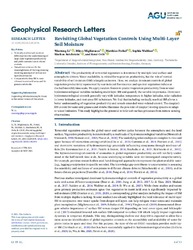Revisiting Global Vegetation Controls Using Multi‐Layer Soil Moisture
DOI: https://doi.org/10.1029/2021GL092856
Persistent URL: http://resolver.sub.uni-goettingen.de/purl?gldocs-11858/9586
Persistent URL: http://resolver.sub.uni-goettingen.de/purl?gldocs-11858/9586
Li, Wantong; Migliavacca, Mirco; Forkel, Matthias; Walther, Sophia; Reichstein, Markus; Orth, René, 2021: Revisiting Global Vegetation Controls Using Multi‐Layer Soil Moisture. In: Geophysical Research Letters, Band 48, 11, DOI: 10.1029/2021GL092856.
 |
Dokument öffnen: |
The productivity of terrestrial vegetation is determined by multiple land surface and atmospheric drivers. Water availability is critical for vegetation productivity, but the role of vertical variability of soil moisture (SM) is largely unknown. Here, we analyze dominant controls of global vegetation productivity represented by sun‐induced fluorescence and spectral vegetation indices at the half‐monthly time scale. We apply random forests to predict vegetation productivity from several hydrometeorological variables including multi‐layer SM and quantify the variable importance. Dominant hydrometeorological controls generally vary with latitudes: temperature in higher latitudes, solar radiation in lower latitudes, and root‐zone SM in between. We find that including vertically resolved SM allows a better understanding of vegetation productivity and reveals extended water‐related control. The deep(er) SM control for semi‐arid grasses and shrubs illustrates the potential of deep(er) rooting systems to adapt to water limitation. This study highlights the potential to infer sub‐surface processes from remote sensing observations. Key Points:
Vertically resolved soil moisture (SM) improves the understanding of large‐scale vegetation productivity and yields extended water‐related controls.
Data‐driven evidence for the meaningfulness of the long‐standing modeling paradigm of vertical soil layer discretization.
Comparatively deep SM is most relevant in semi‐arid areas and for grasses and shrubs.
Statistik:
ZugriffsstatistikSammlung:
This is an open access article under the terms of the Creative Commons Attribution License, which permits use, distribution and reproduction in any medium, provided the original work is properly cited.

